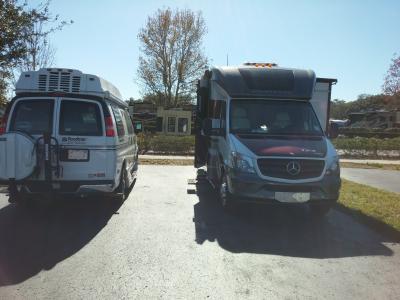Going from a Type B to a Type C: A Small Motorhome Comparison
 Back in January, I traded my Type B 2012 Roadtrek van for a Type C 2014 Winnebago View. I owned my Roadtrek 190 Simplicity for 2 years and loved it. I’ve now owned the Winnebago View Profile 24V for 7 months and also love it. With seven months of use and over 16,000 miles on the Winnebago, I feel I can give a first hand comparison of the two vehicles. I'm not trying to show how one is better than the other or give a detailed feature comparison since they are different vehicles. I just thought it might be helpful to others to share my experiences with the two products.
Back in January, I traded my Type B 2012 Roadtrek van for a Type C 2014 Winnebago View. I owned my Roadtrek 190 Simplicity for 2 years and loved it. I’ve now owned the Winnebago View Profile 24V for 7 months and also love it. With seven months of use and over 16,000 miles on the Winnebago, I feel I can give a first hand comparison of the two vehicles. I'm not trying to show how one is better than the other or give a detailed feature comparison since they are different vehicles. I just thought it might be helpful to others to share my experiences with the two products.
First, let me say that I have no axe to grind and have no affiliation with or compensation from either of the vendors of these motorhomes. Also, I respect that there are folks who love their Type B and would never think of trading up and there are similar folks who love their Type C.
We're all different and have different needs and different uses for our RV's. I'm more of a traveler versus a stay put camper, but I do some stay put camping during the year. I'm also a minimalist camper. I like small, simple, and tend to get by well with the bare essentials.
So, it all starts with the reason why I traded up. I began traveling the country with my Roadtrek and logged over 33,000 miles with it. It is a great road trip vehicle and I loved traveling in it. But my reasons for trading were two fold. First, I wanted to be able to live in an RV for two months parked in Florida for the winter. I found that the living space within the Roadtrek did not suit me for that type of living. This was the major drive for trading up. Second, I wanted to stay with a small motorhome, but have just a little more space like a permanent bedroom.
So why a Winnebago View? It best fit our requirements. I’ll give the specs below, but I think it’s still small, has the floor plan we liked, built on a very reliable chassis, is fuel efficient, is from a large reliable vendor with a large dealer network, and the model has a demand on the trade in market (lots of people own them). I had also talked to several campers who owned them (either a View and Itasca Navion) and all were very pleased with them. I also follow a few blog writers who have them and all have the same positive comments.
So, now the comparison.
Size
Roadtrek - length 20' 5'', width 7', height 8' 9", GVWR 9,600 lbs, wheelbase 155"
Winnebago - length 25' 5", width 7' 6", height 11' 3", GVWR 11,030, wheelbase 170"
The Winnebago is a larger vehicle. For me, the most noticeable difference is the height (its a higher profile). You need to be more cognizant of trees and over hangs. The extra 3" on each side is negligible and I don't notice the extra 5 feet in length. It fits in parking space if you back in and can overhang otherwise it takes 2 spaces. So far, I have been able to go everywhere I went with my Roadtrek.
Features
The living features are very similar between both units. Same type of appliances, heat, hot water A/C, inverter, entertainment, toilet, on board generator, swivel seats, and batteries. The key differences - Winnebago has a 5.3 cu ft frig vs the 3.0 cu ft on my Roadtrek, 2 12V wet cell batteries in the Winnebago vs 2 6V AGM in Roadtrek, Winnebago has tank heaters, hot water heater is AC and propane, all lighting is LED, it has a shower stall, the beds are permanent (no fold out couch), a 16 ft power awning, and a separate range hood that vents outside. For me the biggest differences are the frig - it can hold a lot more food, the permanent beds, and the small slide out give more living space.
Cockpit - I liked the onboard computer on the Chevy Roadtrek. The Sprinter has no TPMS, no fuel range estimate, and no MPG calculation. But you can check the oil from the dash display on the Sprinter. You can also use the coach batteries to help start the Sprinter if the chassis battery is weak. The cockpit on my Sprinter came with built in privacy shades on the windshield and door windows. I like these better than curtains.
Handling
Very similar. They both drive very easy. The extra length of the Winnebago takes a little more looking when making a right hand turn. I found both the Roadtek and Winnebago will get a small push when being passed by a semi. I drove the Winnebago recently in 25-35 mph cross winds. It did want to drift more in the wind and gusts did shove/push it more than the Roadtrek but it was not an unsafe feeling.
Capacities
Roadtrek - freshwater 36 gal, grey 23 gal, black 10 gal, water heater 6 gal
Winnebago freshwater 37 gal, grey 36 gal, black 36 gal, water heater 6 gal
For me, I really like having the larger black tank. I had to dump the Roadtrek every 2-3 days. I can go a week on the Winnebago. The dump on the Winnebago is gravity for the black with a pump to push the grey to the dump hose. I didn't mind the macerator on the Roadtrek. It was easy to use. The dump procedure on the Winnebago has a couple more steps.
Fuel Usage
Roadtrek - my Roadtrek had the 4.8L V8 gas engine. My fuel mileage averaged between 16-18 mpg.
Winnebago - the Winnebago had a 3.0L V6 diesel. My fuel mileage is averaging 15-17 mpg.
Diesel fuel is currently more costly than gas so, I'm paying more for fuel with the Winnebago.
Maintenance
Roadtrek - I only had one incident where I needed to go to the dealer and that was to do a propane test. My Roadtrek was super reliable. The Chevy Roadtrek could be also be serviced just about anywhere. I did all my own routine maintenance and the cost of supplies and parts were reasonable.
Winnebago - The frig was DOA when we first started it up but that got replaced before we left the lot. Otherwise there's been no problems no far. The maintenance for the Sprinter is not as available as the Chevy. The cost (parts and labor) is also more. An oil change takes 13 qts of oil and a filter you need to get from MB. The diesel needs a regular fuel filter replacement and DEF added every 3,600 miles. Everything from MB is expensive. An extra key for the Sprinter cost almost $200. For the Chevy it cost $50.
User Groups
Roadtrek - I found little value in the RT International Group. The Yahoo group has 3,200 users and the Roadtreking FB group has almost 2,400 members. Both are very active and responsive to questions.
Winnebago - There is a Winnebago Owners Club (WIT Club). There's a small (160 members) FB group and there is a Yahoo group for Views/Navions owners with 6,500 users who are also very active and responsive. There's also the Sprinter Forums group for Sprinter specific issues.
Costs
Roadtrek - My RT 190 Simplicity had a list price of $84K. I paid $71K
Winnebago - My View Profile 24V with just about every available option listed for $122K (the paint job was a $6K option). I paid $52K plus gave them my two year old Roadtrek.
So that's the comparison from my perspective. The bottom line - They both are great vehicles. Both are reliable. They drive very similar and can pretty much go the same places. I like having the extra space and for that I'm paying more for fuel and maintenance for the Winnebago. But I made that decision so I would have something to live in while wintering in FL.
Follow more of my travels at http://jdawgjourneys.blogspot.com



0 Comments
Recommended Comments
There are no comments to display.
Please sign in to comment
You will be able to leave a comment after signing in
Sign In Now